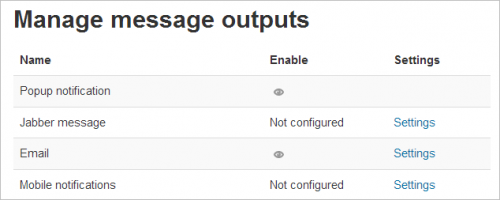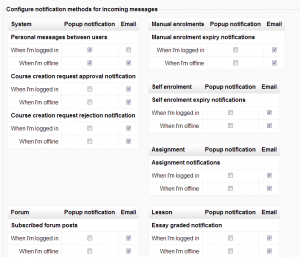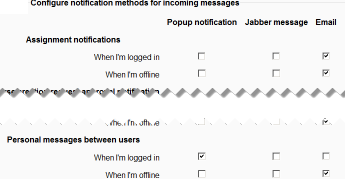Enabling Messaging
Enabling / disabling messaging site wide
The messaging system in Moodle is enabled by default. It may be disabled by a site administrator in Administration > Site administration > Advanced features > Enable messaging system.
Site administration: Message outputs
Most of the Messaging system default settings are set in Site administration > Plugins > Message output.
Manage Message outputs
There are four default types of output methods for messaging: popup notices, Jabber IM type messages, messages sent as email and mobile notifications
Each of these can be enabled or disabled independently by a site administrator in Administration > Site administration > Plugins > Message outputs > Manage message outputs.
By default Popup and Email are both enabled, though email will only work of course if the site has been properly configured to deliver email. Jabber and Mobile notifications are off by default and need to be configured first.
Popup notification
Has no settings. It can be enabled or disabled. How it appears will depend on some extent to the theme.
Jabber message
Jabber must be configured before use.
(Could someone with working settings fill this out with example?)
- Host - The server to connect to to send jabber message notifications - full hostname (e.g. jabber.org)
- Server - XMPP host ID (can be left empty if the same as Jabber host)
- Username - The user name to use when connecting to the Jabber server
- Password - The password to use when connecting to the Jabber server
- Port - defaults to 5222
SMTP hosts
SMTP stands for Simple Mail Transfer Protocol. The SMTP host is an email relay that will take the email from Moodle and send it to users. You will need to set this only if your server does not allow mail relay. Otherwise, PHP will send out the mail using its built-in mail server. All the email sent by forums and other modules will be sent through this host.
Most SMTP hosts make use of the default port 25 to for listening email traffic. However, occasionally a non-default port is used. In such cases, entering an SMTP host followed by a colon (i.e. :) and the port number should work. For example, if my SMTP host is myemailserver.com and it listens on port 587 or 465 (most common) instead of port 25 I would enter the SMTP host as myemailserver.com:587.
No-reply address
You can specify here the default email address you wish to use as the "From" address where users cannot reply directly to others (eg when a user chooses to keep their address private).
It is possible to check a box to enable 'Always send email from the no-reply address'. This can be used to stop anti-spoofing controls in external mail systems blocking emails. The default setting is 'No'.
SMTP security
If the SMTP server requires a secure connection, the correct protocol type, SSL or TLS, may be set.
Configure HTTPD/SELinux on CentOS/Red Hat (RHEL) 6.2/6.1/6
Most new installations of Centos/Red Hat have SELinux activated and is configured by default, rather strictly. In this state SELinux does not allow Apache (httpd,phpmailer) to use the sendmail function and make any sort of network connection.
If you continue to have problems with sending/authenticating use the getsebool command to find out if SELinux is one of the culprits. When the getsebool command is issued it returns on or off.
Type to check if your Apache is allowed to send mail and make a connection over the network
- getsebool httpd_can_sendmail
- getsebool httpd_can_network_connect
You will receive the values of httpd_can_sendmail and httpd_can_network_connect. Let's assume both options are off:
- httpd_can_sendmail -->off
- httpd_can_network_connect -->off
We need to change the values from off to on by using setsebool. Number 1 = on and 0 = off. Type the following:
- setsebool -P httpd_can_sendmail 1
- setsebool -P httpd_can_network_connect 1
You will not receive a response. You can double check if the setsebool command worked by using getsebool and see if the values changed from -->off to -->on.
Mobile notifications
The administrator can configure the site to push messages to mobile devices. Moodle pushes messages to a messaging server, which then pushes it to Apple or Google depending on the platform the target device is using (iOS or Android).
The default messaging server is a free Airnotifier server maintained by moodle.com which registered sites may use for testing (be aware that all your messages will go via this server). To connect to this, click 'Request access key' and then add it to the Airnotifier access key field. Alternatively, you may install your own private Airnotifier server and use that instead. See https://github.com/dongsheng/airnotifier for details.
Users will need to connect at least once with the latest version of the mobile app to register their phones with the site. Then they can configure their own messaging preferences in Administration > My profile settings > Messaging.
Default message outputs
The user defaults for these are set in Administration > Site administration > Plugins > Message outputs > Default message outputs.
You can specify the default outputs for each type of message that Moodle can send.
Permittedness
You can also set to what degree each type of message is enabled, and whether users are able to change these default settings in their profiles:
- Disallowed - This particular type of message is not allowed at all and users will not see any settings related to them. Message of the chosen type will never be delivered.
- Permitted - Users are permitted or allowed to change the settings. When the user account is created, the new user will inherit the settings the administrator sets here, but will be allowed to change them afterward in their Messaging settings. Messages will be delivered as the user sets them on their own Messaging settings page.
- Forced - Users are not permitted or allowed to change these settings. When the user account is created, the new user will inherit the settings the administrator sets here and will never be allowed to change them. Messages will be delivered for all users as you set them on this page.
Logged in/Offline
You can set whether each of these will be sent when the user is online through the messaging system interface available to users in their profiles, and/or whether each output is sent via email.
Ordering of messaging settings
Because users might have many different messaging options, they are ordered into different components -for example, Forum, Assignment, System, Enrolments etc.
List of message types
Except for Personal messages between users, which refers to the interaction messaging tool on a user profile, the other messages are generated by events in Moodle. These are set in the system by the Administrator in Site administration > PLugins > Message outputs > Default message outputs.
| Output Name | Description | Recipients |
|---|---|---|
| Assignment notifications | Student has submitted an assignment | Teacher |
| Warning when your quiz attempt becomes overdue | See Quiz settings | Student |
| Available update notifications | Notice of new releases of Moodle code | Site administrators |
| Backup notifications | Automated backup schedule run completed | Site administrators |
| Badge creator notifications | Notify creator of a badge when it is awarded to someone | Any badge creator (typically Teacher or Manager role) |
| Badge recipient notifications | Notify recipient of a badge when it is awarded to them | Any badge recipient (typically Student role) |
| Comment posted on a learning plan | ? | ? |
| Comment posted on a competency | ? | ? |
| Confirmation of your own quiz submissions | Notice your quiz was successfully submitted | Student |
| Course creation request approval notification | Notice a requested course has been approved | Defined in Site admin > Courses > Course request > Course request notification |
| Course creation request notification | Notice a course has been requested - See Course request | Defined in Site admin > Courses > Course request > Course request notification |
| Course creation request rejection notification | Notice a requested course has been rejected | Defined in Site admin > Courses > Course request > Course request notification |
| Subscribed forum digests | Sets default for this for user profiles | Authenticated users |
| Important errors with the site | Important errors - See also Debugging | Site administrators |
| Manual enrolment expiry notifications | Notice if Manual enrolment about to expire | Manual enrolees |
| Self enrolment expiry notifications | Notify users when their enrolment expires | Enroller only, or Enroller & Enrolled user |
| Lesson essay graded notification | Notify students a teacher has graded a Lesson essay question | Student |
| Personal messages between users | Using the Messaging interface tool | Authenticated Users |
| Message to confirm that an inbound message came from you | See Incoming mail configuration | Authenticated Users |
| Feedback reminder | Feedback non-respondent reminder message | Student feedback activity non-responders |
| Warning when an inbound message could not be processed | See Incoming mail configuration | Authenticated Users |
| Confirmation that a message was successfully processed | See Incoming mail configuration | Authenticated Users |
| Notices about minor problems | Site administrators | |
| Notification of rule subscriptions | Notifications from Event monitoring rules | Event rule subscribers |
| Subscribed forum posts | Default for forum subscription handling | Anyone subscribed to a forum |
| Feedback notifications | Notices from setting Enable notification of submissions | Teacher, Feedback administrator |
| Notification of quiz submissions | Message that student has submitted a quiz | Teacher |
Roles and Messaging capabilities
The following capabilities can be applied as permissions to make custom changes to roles affecting messaging.
- course:bulkmessaging - Send a message to many people
- site:readallmessages - Read all messages on site
- site:sendmessage - Send messages to any user
- user:editownmessageprofile - Edit own user messaging profile
- user:editmessageprofile - Edit user messaging profile
User profile settings
Users can receive message alerts for a number of different reasons and can also send and receive instant messages. How a user receives notification of incoming messages can be set in Logged in user menu > Preferences > Messaging.
This brings up a screen with check boxes where users can choose how they wish to be notified both when logged in and logged out. They can choose between a pop up,Jabber message or an email.
Note: The choices a user has on this screen depends on their role and permissions within Moodle. For example, an administrator would see options for notifications about backups or important errors with the site.
An administrator can receive update notifications for both Moodle core code and any contributed plugins installed on the site if the automatic check for available updates is enabled in Administration > Site Administration > Server > Update notifications.
Pop up
When a user is logged into Moodle, the message will pop up from the bottom right corner of the page. The user can choose to read the message immediately or to ignore it. If they choose to ignore it, the message returns until it is read.
Jabber
If the Jabber server has been configured, Jabber messages can be sent.The Jabber ID can be set at the bottom of the screen.
Users cannot by default automatically choose to have notifications sent to a different email address from their official Moodle email. However, the administrator has the option to override this so that users can have an alternative email. This is done from Administration > Site administration > Advanced features and when activated, a box will appear for users to enter another email address.
Note: The 'messagingallowemailoverride' setting does not affect failed log in notifications as they do not go through the messaging system, and will therefore still go to the original email specified.
Mobile notifications
Users have this option if their site is connected to a messaging server and if they have connected with their mobile device to the mobile app.
Prevent non-contacts from messaging me
Non-contacts can be prevented from sending messages by ticking this box in General Settings at the bottom of the screen.



